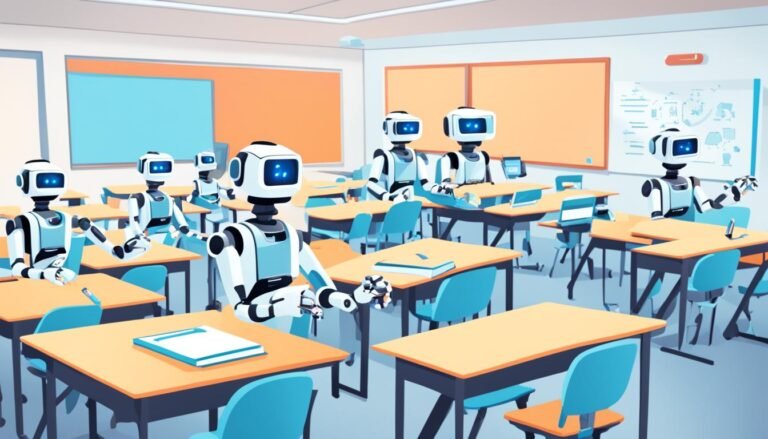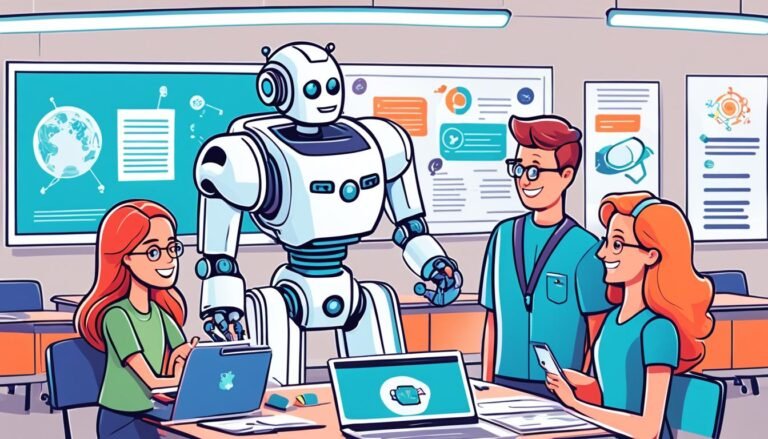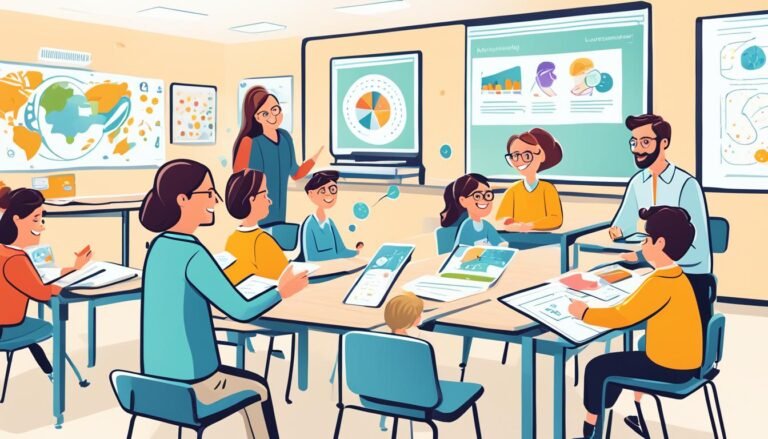AI in Student Assessment: Enhancing Education
Imagine being in a classroom where everyone’s unique skills and struggles are noticed and acted on quickly. Teachers stop spending their nights buried in papers or entering grades by hand. Instead, technology that uses AI works with them. This ensures all students get the help they need right away.
More and more, developers are using AI in creating, scoring, and reporting on tests. These AI tools offer quick tips for improvement, making learning more efficient. But, because not all students have the same opportunities, better and fair ways to test are needed.
Let’s look at Khanmigo AI from Khan Academy, an AI tool changing how teachers and students connect. These interactive bots, like Khanmigo, grab student interest and provide teachers with detailed performance reports. It’s a huge step in student testing with AI. It offers personalized education tailored to each student’s unique situation and needs.
Technology in education is changing fast, so local and state policies should also change. They need to focus on personalized teaching to really help teachers. Working with experts and teachers is key. This helps create tests that work for each student using AI, something 85% of schools are starting to do.
Key Takeaways
- AI technologies in education are transforming student assessments.
- Real-time feedback and instructional efficiency are major benefits of AI-driven education.
- Addressing inequities requires enhanced and personalized assessments.
- Combining AI tools with human input creates comprehensive learning experiences.
- Collaboration across educators, researchers, and policymakers is vital for successful AI integration.
The Evolution of Student Assessments with AI
The use of AI is changing how we test students. We’re moving from old-fashioned tests to new, digital methods. These new methods look at students in more detailed ways. They show us how well students understand topics and use their knowledge.
This change is all thanks to AI getting better at understanding human language. It’s a big move forward in how we test and learn.
The Shift from Traditional to Modern Assessments
Old tests didn’t cover all the skills students need today. But with AI, we’re finding new ways to look at these skills. For example, more than 370 schools around the world are part of the Mastery Transcript Consortium. They use AI to see how well students do in not just school subjects, but also in life skills and getting along with others.
In Chile, there’s a test that looks at a student’s personal qualities and how well they work in their community. This kind of testing is important because the world is looking for people who can think creatively and solve problems well. A study from the World Economic Forum shows that these skills are really needed in jobs.
The Role of AI in Revolutionizing Assessment Methods
AI is changing how we do tests by making learning personal and giving feedback right away. In South Korea, there’s an app that gives students tests that are just right for them. This app also suggests what they need to study. It does this by looking at student’s work with AI.
In Singapore, there’s a tool that helps teachers with English class. This tool fixes small mistakes in students’ writing. With the tool’s help, teachers can focus on teaching in a deeper way. AI handles the small mistakes, like grammar and spelling errors.
Changes like these are happening in many places. In Iowa, students are using a video game to learn about making good decisions and working together. In Switzerland, people training to be electricians are using virtual platforms to get ready for their real jobs.
Now, education is all about skills like thinking in new ways, being strong when things are hard, and talking well with others. AI is really important in helping students get better at learning how to learn. In Australia, there’s a new way of using AI to help students think better and get more creative.
The use of AI in testing students is really changing how we see education. It’s making learning more about each student and finding out what they’re great at.
- Personalized formative assessments with AI in South Korea.
- AI-powered student feedback mechanisms in Regulatory Affairs.
- Innovative evaluation methods like Crisis in Space in Iowa.
- Virtual learning platforms for practical exam preparation in Switzerland.
AI-Powered Assessment Tools in Modern Education
Artificial intelligence is quickly becoming a part of education. Schools and colleges use AI tools to make learning better. These tools help with things like grading essays and understanding how to teach students better.
Types of AI Tools Used in Student Assessments
Today, many AI tools are used to check how well students are doing:
- QuillBot – This tool is good at rephrasing, summarizing, and checking grammar.
- Grammarly – It gives instant tips on grammar, spelling, and more. This helps students write better.
- Owlfit (formerly ELI5) – It makes hard topics easy to understand, fitting different learning styles.
- AI-driven chatbots – They are used to test decision-making skills in some student exams.
Benefits of AI-Powered Tools for Educators and Students
Using AI in learning brings many good things for teachers and students:
- Personalized Learning: AI can adjust lessons to fit each student’s needs. This makes learning better for everyone.
- Accessibility: It helps people who learn in different ways or who have special needs to learn better.
- Administrative Efficiency: AI can do tasks like grading, which helps teachers focus on teaching.
- 24/7 Support: Chatbots and virtual assistants are always ready to help students whenever they need it.
AI tools help build a learning space where everyone can grow. They give quick feedback and help students understand how they are doing.
Natural Language Processing in Education
Natural Language Processing, or NLP, is changing how we assess students. It offers advanced learning tools using AI. These tools help understand students’ answers better, especially their critical thinking and how they express themselves.
How NLP Enhances Understanding of Student Responses
Imagine a tool that can grade written test answers from students. This is what the Texas Education Agency’s NLP technologies aim to do. They focus on essays in state tests, starting from third grade, which are often open-ended.
Thanks to these tools, the number of human graders in Texas has dropped a lot. It went from needing 6,000 to just 2,000. This marks a big change in how efficiently we can handle student assessments. But, there are worries about how well these tools grade students who are learning English. About 1 out of every 5 students in Texas is an English learner.
This NLP system was trained using 3,000 sample answers. Another check is then done on a quarter of the grades the system provides. This is to make sure the grading is both fair and accurate.
Applications of NLP in Student Assessments
Across the U.S., many states are now using NLP for tests. At least 21 states have joined this trend. These tools are used to grade essays and answers to open questions, making the grading process bigger and better. Also, NLP helps with understanding spoken words and turning them into text. This makes learning more accessible to everyone.
Besides tests, NLP is also helping students get better at writing and researching. It gives them feedback that is just for them. Because of these benefits, NLP is quickly becoming a key technology in education. By 2023, 29% of education places will be using NLP, and more plan to start. This means a lot more students will have a chance to learn with NLP.
The use of NLP is growing fast in education. Still, we must watch out for any unfair practices and make sure everyone is graded fairly.
- Texas Education Agency rolled out a natural language processing program for scoring standardized tests.
- Auto-scoring system reduces need for human scorers from 6,000 to 2,000.
- 21 states use natural language processing for grading standardized tests.
- Concerns raised over fairness for bilingual and English learner students.
- NLP expected to grow at a CAGR of 36.6% between 2022 and 2030.
The Promise of Automated Grading Systems
Automated grading systems have changed how we evaluate student work. They let teachers quickly check papers and use time better. Yet, there are issues to handle for fair assessment.
Efficiencies and Challenges in Automated Grading
With AI, grading papers is much faster than before. Students can get feedback right away. But, grading might miss some important behaviors. Also, not all schools use the same standards, which is a problem.
AI struggles with things that need human judgment, like English essays. There can also be mistakes in grading due to how responses are analyzed. Now, a mix of AI and human checking is suggested for better accuracy.
Impact on Teacher Workloads and Student Outcomes
Using AI for student evaluation makes learning systems better. It makes grading easier for teachers. And they can spend more time helping each student.
Even with mistakes, tools are getting better. They learn to help each student uniquely. The goal is to use AI’s strength and human understanding together.
| Element | AI Solution | Benefit | Challenge |
|---|---|---|---|
| Assignments & Exams | Automated Grading Tools | Reducing Teacher Workload | Subjectivity |
| Immediate Feedback | NLP Algorithms | Improving Academic Outcomes | Error Rates |
| Science & Math | Rule-Based Grading | Consistent and Fair | Complex Responses |
The future of grading systems depends on AI growth. It should work with teachers to give fair and accurate tests.
AI for Evaluating Student Performance
AI is changing the game in how we track student success. It’s using personal learning and quick feedback to make a big difference. Now, teachers can handle more info and create materials that meet each student’s needs better. This is sparking better learning and more success for students.
Real-Time Feedback and Personalized Learning Journeys
AI tools are key in figuring out what each student needs. They look at what students are good at and what they need help with. Then, they make lessons just for them. With AI’s help, students can learn at their own speed and get feedback right away. This quick feedback shows them where they can improve now.
AI is also helping to make learning materials easier to use. It’s adding things like reading aloud, turning speech into text, and translating languages. These help all students get the info they need, no matter their challenges. Plus, AI helps grade work, which makes sure grades are fair and cuts down on how much teachers have to do.
Case Studies: Successful Implementations of AI in Performance Evaluations
Real stories show how big a change AI is making in schools. For example, Coursebox has helped make over 20,000 lessons in more than 60 languages. Magic School AI has more than 60 special tools to help teachers. And Gradescope shares detailed info about tests and programming work. These tools help teachers do better with their lessons and tests.
| Platform | Features | Impact |
|---|---|---|
| Coursebox | 20k courses in 60+ languages | Enhanced course creation capabilities |
| Magic School AI | 60+ AI tools, LMS integration | Seamless integration for customized learning |
| Gradescope | Detailed analytics and insights | Improved assessment and feedback mechanisms |
| Classpoint | Real-time quizzes, presentation tools | Interactive learning experiences |
| Examsoft | Exam readiness assessments, WiFi blocking | Ensured academic integrity and readiness |
| Quizgecko | Focus on personalized learning | Trusted by top institutions |
Schools like Clark University and the University of Sheffield are using Quizgecko. This shows how well these AI tools work. Schools and companies making edtech are always trying new things. They want to make learning better and give students the help they need, right when they need it.
AI in Student Assessment
Using AI in tests helps make learning better and more useful. It gives quick, detailed feedback, focusing on how each student can improve. These new ways of testing not only grade your work fast, they help you learn better, too.
AI is making tests better but there are worries. Some people are not sure if AI can check well enough. They say working together on tests could help stop people from cheating. This idea of learning together can make tests fairer with AI.
Tests with AI look at each student’s progress all the time. By working together and using smart technology, these tests can be very accurate and helpful. They can make the tests feel real, like you’re solving a problem in the real world.
| Aspect | Traditional Assessments | AI-Driven Assessments |
|---|---|---|
| Feedback | Delayed and generic | Immediate and detailed |
| Personalization | One-size-fits-all | Adaptive to individual needs |
| Bias | Human biases present | Minimized through automation |
| Security Concerns | Traditional methods | Issues with text, image integrity |
AI in tests supports Goal #4 for better education and learning for everyone. It’s also helping areas like project management and data use the newest AI tools. With AI, we can test students in smarter, fairer ways.
Tests using AI encourage real teamwork and deal with real problems. They check how well you do alone and with others, just like in life. AI makes tests that are fair and really helpful for learning.
Machine Learning in Academic Evaluation
Machine learning changes how we check students’ work. It looks at lots of data to find patterns and help teachers make better plans. This way, students can get help that fits them best.
AI makes grading fairer and helps teachers mark work faster. Websites like Turnitin and Gradescope use AI to check work for honesty. They help grade papers and tests quickly and fairly.
AI gives feedback that’s just right for each student. By spotting what each student needs to work on, it helps them get better. For instance, AI can read written work and give advice that fits.
AIs don’t just grade, though. They also help students think better by reviewing each other’s work. They’re even starting to judge creative projects in subjects like art and music.
Using AI for tests does bring up some big questions, like about privacy and fairness. Mixing human feedback with AI feedback is also really important. But, as AI gets better, it will make more sense for more types of school subjects.
Researchers find that AI is great for teaching new things and working together. It’s been a big help in fields like geography and medicine. And it makes lessons more interesting for students.
Real-World Applications: Virtual Reality and AI in Assessments
The world of education is changing fast. Virtual reality and AI are changing how we test students. With these technologies, tests become like games. This makes learning more fun and helps students solve real problems better.
Virtual Learning Environments and Practical Exams
A study on lab safety taught us a lot. Students did equally well on easy tests, no matter the method. But when faced with real lab challenges, those in immersive VR did best. This shows the power of immersive learning.
Virtual reality helps to understand hard theories in subjects like biology. It also lets students visit places they normally can’t, making learning more exciting.
Engaging Students with Gamification and Interactive Tools
Adding fun games and VR to tests can really help students learn. These tools make tests interesting, so students remember more and stay excited about learning.
Social VR is also great for working together and making learning less stressful. It’s helpful in many areas, from the environment to medical training. Firms use VR for staff training too.
With VR becoming more available, education’s future looks bright. Schools like UCLA are even using smart tools to help students do better. These changes show big hope for the future of learning.
| Study Method | Performance on Basic Knowledge Tests | Performance in Real Laboratory |
|---|---|---|
| Traditional Safety Manuals | Equal Performance | Lowest Performance |
| Desktop VR | Equal Performance | Moderate Performance |
| Immersive VR | Equal Performance | Highest Performance |
Using VR and AI in tests has big benefits. From immersive learning to fun quizzes, they make learning better and prepare students for life.
Addressing Ethical Considerations in AI-Driven Assessments
AI is now a big part of testing students. It’s key that we address ethical issues like being fair, keeping things private, and making sure everyone knows how the AI works.
Fairness, Privacy, and Algorithmic Transparency
Using AI in education asks for a solid plan. This promises fairness and privacy. It’s important to share how AI is trained and used. This keeps things accurate and safe.
The worry about the political side is big too. AI must not spread unfair content. Also, we need to watch out for the environment. AI uses a lot of energy, and we must manage it well.
We must make AI welcome for everyone, without unfairness. This means no biases and making sure all have a chance to use it.
“Transparency and oversight: Questions exist on how generative AI tools are trained and whether safeguards protect against inaccurate information or harmful interactions, particularly concerning tools owned by corporations.”
Strategies for Mitigating Bias in AI Systems
Handling AI bias means always getting better and using many different kinds of data. It’s vital to fight bias in AI tools and the big language models. This makes AI in learning fair and square.
To keep things just and private, we need technology to be strong and safe. It’s a must to look hard at how we use, keep, and share user data. And we must be very careful about privacy with big language models.
Focus on making learning fair and show how grades are decided. This helps cut down on biases. Also, keep student privacy and their work safe. As AI gets more used, this gets more important.
By tackling these ethics and taking smart steps, we make AI tests better and still keep things fair, private, and clear.
Conclusion
The future of AI in education is bright. It brings tools and solutions that will change how we learn. It aims to make learning personal, engaging, and inclusive. Students will get the support they need, making education more interactive.
AI will help with tasks like grading. This lets teachers spend more time with students. AI also looks at data, showing teachers how students are doing. It points out where students need help, making education better.
But, AI might cause some jobs to change and could make learning less personal. It’s key for teachers and policy makers to use AI wisely. This means keeping the focus on students and their needs while using new technology. By doing this, AI can make learning even better without taking away the human side of teaching. It’s important to use AI right and include everyone. This will lead to a future where education is better for everyone.
Source Links
- How AI Can Help Create Assessments that Enhance Opportunities for all Students
- 6 Practical Approaches of AI for Learning Assessments to Boost Student Success (2024)
- AI in Adaptive Assessment | Enhancing Student Evaluation
- AI, VR, And The Future Of Assessment In Schools
- Evolving Student Assessment: Integrating Rubrics with AI for Personalized and Equitable Education
- The Evolution of Education: How AI is Reshaping Grading
- AI and Other Tech Can Power Better Testing. Can Teachers Use the New Tools?
- 10 Best AI Tools for Education (Students & Teachers) in 2024
- How AI will transform higher education
- Is It Fair and Accurate for AI to Grade Standardized Tests? – EdSurge News
- AI and assessment: Rethinking assessment strategies and supporting students in appropriate use of AI : My College
- Natural Language Processing in EdTech: A Deep Dive into the Future of Learning
- Are AI-based Automated Grading Systems the New Teaching Assistants? | Magic EdTech
- AI-Graded Assessments: The Pros and Cons of Automated Grading
- The Promises and Challenges of Artificial Intelligence for Teachers: a Systematic Review of Research – TechTrends
- How Can AI Tools Improve Student Assessment Outcomes?
- Top 10 AI Assessment Tools For Educational Institutes | Coursebox AI
- AI and Assessment: Where We Are Now | AACSB
- Frontiers | AI and student assessment in human-centered education
- The Future of Student Assessment in the Age of AI and ChatGPT – Higher Education Digest
- Assessment of student learning is broken (opinion)
- AI in Higher Education: Impact of AI on Student Assessment | Tensorway
- Artificial Intelligence for Student Assessment: A Systematic Review
- Incorporating AI in Learning Assessments: A Guided Pathway
- Role of AR and VR in Learning and Assessment – EON Reality – AI Assisted XR-based knowledge transfer for education and industry
- Virtual Reality for Learning and Assessment
- How AI is Revolutionizing Education
- Ethical AI for Teaching and Learning
- Artificial intelligence in education: Addressing ethical challenges in K-12 settings
- Ensuring Equity: The Role of AI in Education Ethics
- What is the Conclusion of Artificial Intelligence in Education?
- The Pros And Cons Of AI In Education And How It Will Impact Teachers In 2023 | ClassPoint
- The Future Benefits of Artificial Intelligence for Students







